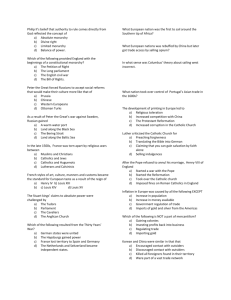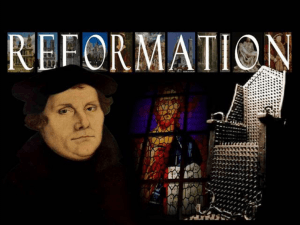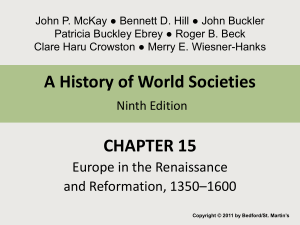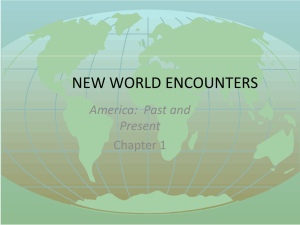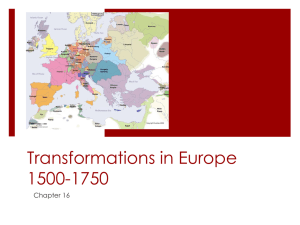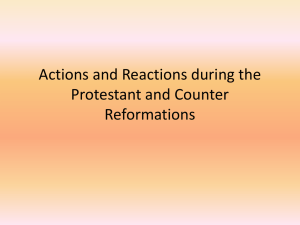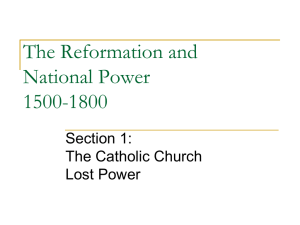Protestant Reformation
advertisement
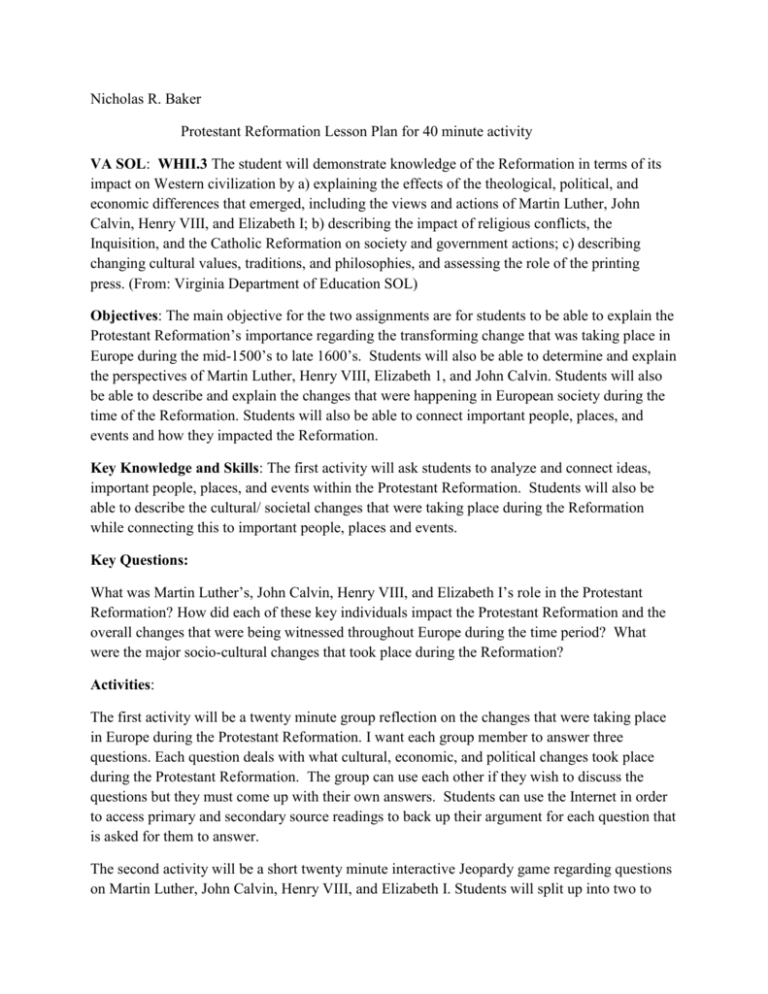
Nicholas R. Baker Protestant Reformation Lesson Plan for 40 minute activity VA SOL: WHII.3 The student will demonstrate knowledge of the Reformation in terms of its impact on Western civilization by a) explaining the effects of the theological, political, and economic differences that emerged, including the views and actions of Martin Luther, John Calvin, Henry VIII, and Elizabeth I; b) describing the impact of religious conflicts, the Inquisition, and the Catholic Reformation on society and government actions; c) describing changing cultural values, traditions, and philosophies, and assessing the role of the printing press. (From: Virginia Department of Education SOL) Objectives: The main objective for the two assignments are for students to be able to explain the Protestant Reformation’s importance regarding the transforming change that was taking place in Europe during the mid-1500’s to late 1600’s. Students will also be able to determine and explain the perspectives of Martin Luther, Henry VIII, Elizabeth 1, and John Calvin. Students will also be able to describe and explain the changes that were happening in European society during the time of the Reformation. Students will also be able to connect important people, places, and events and how they impacted the Reformation. Key Knowledge and Skills: The first activity will ask students to analyze and connect ideas, important people, places, and events within the Protestant Reformation. Students will also be able to describe the cultural/ societal changes that were taking place during the Reformation while connecting this to important people, places and events. Key Questions: What was Martin Luther’s, John Calvin, Henry VIII, and Elizabeth I’s role in the Protestant Reformation? How did each of these key individuals impact the Protestant Reformation and the overall changes that were being witnessed throughout Europe during the time period? What were the major socio-cultural changes that took place during the Reformation? Activities: The first activity will be a twenty minute group reflection on the changes that were taking place in Europe during the Protestant Reformation. I want each group member to answer three questions. Each question deals with what cultural, economic, and political changes took place during the Protestant Reformation. The group can use each other if they wish to discuss the questions but they must come up with their own answers. Students can use the Internet in order to access primary and secondary source readings to back up their argument for each question that is asked for them to answer. The second activity will be a short twenty minute interactive Jeopardy game regarding questions on Martin Luther, John Calvin, Henry VIII, and Elizabeth I. Students will split up into two to five teams and each member of the team must respond to the question that is being asked on the game. The team with the most points at the end of the activity will win the game. Use of Technology: Students will use interactive software during the Jeopardy game activity. Students will also use online resources to look at primary and secondary sources to ascertain the validity of their answers regarding the questions asked on the second activity worksheet. Two Part Protestant Reformation Activity: Directions: Part One: I. Split students into four groups that represent England, Russia, France, and Spain. II. Randomly select one student to be an expert/representative or monarch in the classroom. III. Have students spend 2 minutes on each country between all four countries. For ten minutes students will go around to all four countries and answer the respective questions. IV. The questions we will ask them will be given on a handout to answer on a piece of paper: 1. What is the respective countries affiliation to the church? What position did the countries leader take during the Reformation? (What group did the leader support?) 2. How many Catholics/Protestants were in the respective country? 3. Travel/ Passport: Have students read information on the country? Read questions. 4. What was the country like prior to and during the Reformation or before the Thirty Years Wars? 5. What was the respective countries position during the Thirty Years Wars? Part Two: I. II. III. Have students answer the same questions that they answered for the countries above. Have students take the position of a Calvinist, Lutheran, or Catholic. State where the groups are located in and etc. Protestant Reformation Class Activity on the Differences and Similarities between European Countries Information on England for Passport: Henry VIII was king of England during the Reformation. He was married to Catherine of Aragon. His marriage was a fairly unhappy marriage that led him to eventually go to the Pope to ask him to issue a divorce from Catherine. The Pope did not agree to this. Eventually, Queen Elizabeth I ruled the throne. 1. What is England’s affiliation to the Roman Catholic Church? What group did Henry VIII and Queen Elizabeth 1 support? Henry VIII and Queen Elizabeth 1 both supported Protestants. Henry VIII broke away from the Catholic Church due to the pope not letting his divorce go through. Henry VIII eventually created the Church of England and consequently appropriated land and wealth from the Catholic Church in England. Queen Elizabeth I also supported the Protestants/ dissenters this was in contrast to her sister “Bloody Mary” who totally did not tolerate Protestants/dissenters. Queen Elizabeth I also decided to support Dutch Protestants in their war against Spain and was consequently responsible for the destruction of a Spanish armada that was sent by Phillip II. 2. How many Catholics/Protestants were in England during the Protestant Reformation? More or less Roman Catholics/Protestants 60% Protestants in England today. There were probably more Protestants in England then Roman Catholics due to Henry VIII and Queen Elizabeth 1 tolerance for dissenters. 3. What was England like prior to the start Thirty Years Wars? England was going through various changes thanks to Henry VIII and Queen Elizabeth I. 4. What was England’s position during the Thirty Years Wars? England did not fight during the Thirty Years Wars they stayed pretty much neutral throughout the conflict. Information on France for Passport: In France the monarchy under Henry IV issued the Edict of Nantes in 1598. This ruling was critical to the relationship between Huguenots (Calvinist Protestants) and Roman Catholics. Cardinal Richelieu during the Thirty Years Wars essentially refocused the Reformation from a religious conflict into a political conflict. 1. What is the respective countries affiliation to the church? What group did the leader support? They were overwhelmingly Roman Catholic. However, France was close to having a Protestant King. 2. How many Catholics/Protestants were in France during the Reformation? More or less Protestants/Roman Catholics in France. France was for the most part Roman Catholic however there was a huge population in Southern France of Huguenots. They were in control of over 200 towns in France. The French at this point almost came under the control of a Protestant king for the most part. 3. What was France like prior to the start of the Thirty Years Wars? France was a monarchy. France primarily was under the influence of John Calvin/ Calvinism. The Habsburgs was one of France’s greatest enemies due to various reasons. This would later have a significant impact France’s position during the Thirty Years Wars and their view towards Spain who was under the Habsburgs control. 4. What was France’s position during the Thirty Years Wars? France fought on the side of the Protestants during the Thirty Years Wars despite the fact that Cardinal Richelieu was vehemently against Protestants. Louis XIV. France decided to fight against the Roman Catholic Church due to their respective hatred towards the Habsburgs in Spain. Many members of the Roman Catholic Church in France wanted to sell out France to Spain and the Habsburgs. Information on Spain for Passport: Spain was under the rule of King Ferdinand and Queen Isabella from the later 1400’s to early 1500’s. Phillip II eventually becomes ruler of Spain. Queen Elizabeth 1 of England defeated the Spanish Armada in 1588. King Ferdinand, Queen Isabella, and Phillip II not only had a significant impact regarding their views on the Roman Catholics and Protestants but they also had a significant impact on Spain’s Jewish population as well during the Counter Reformation and the Inquisition. 1. What is the Spain’s affiliation to the Roman Catholic Church? What position did the countries leader take during the Reformation? (What group did the leader support?) They allied themselves with the Roman Catholic Church. 2. How many Roman Catholics/Protestants were in Spain during the Reformation? More Roman Catholics or more Protestants There were more Roman Catholics then Protestants during the Reformation in Spain. 3. What was Spain like prior to the Thirty Years Wars? Spain was under the control of the Habsburgs and the Roman Catholics. 4. What was Spain’s position during the Thirty Years Wars? With the Roman Catholics. Information on Germany for Passport: Germany was split down the middle between the north and the south. Protestants were on one side and Roman Catholics on the other. Remember north/south not east/west. 1. What is the respective countries affiliation to the church? What group did the leader support? Charles V was vehemently against Lutherans (Protestants) in Germany. The Peace of Augsburg essentially allowed each German Prince to decide which religion would be allowed in his state. Northern Germany Protestantism, Southern Germany Catholic. Germany was essentially an empire with multiple princes or rulers of states. 2. How many Catholics/Protestants were in Germany during the Reformation? More or less Roman Catholics/ Protestants. About the same actually. The North was primarily dominated by Protestants and the South was dominated by Roman Catholics. 3. What was Germany like prior to the Thirty Years Wars? Lutheran Reformation and eventually a second reformation or the Calvinist Reformation. Germany was split down the middle. North Germany was primarily dominated by Protestants and the South by Roman Catholics. 4. What was Germany’s position during the Thirty Years Wars? Germany took both sides essentially because it was the primary battlefield for European powers during the Thirty Years Wars. Germany lost about 20% of their population during this conflict. ****Randomly assigned which position via dice. 5. What were the positions of the Calvinists, Lutherans, and Catholics?

